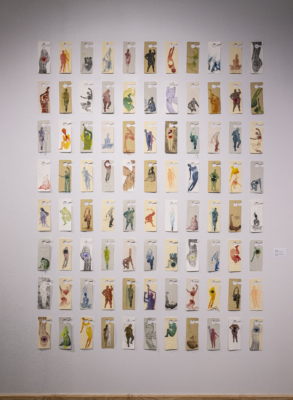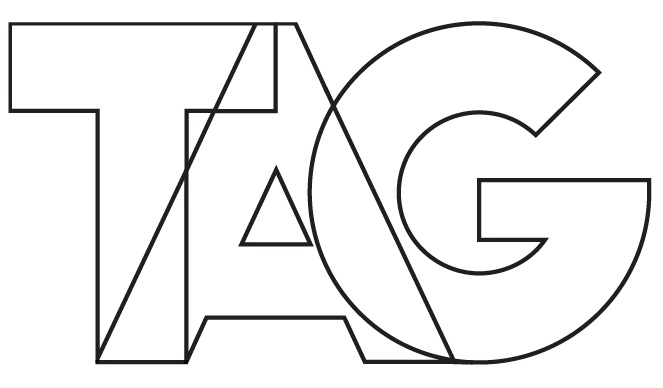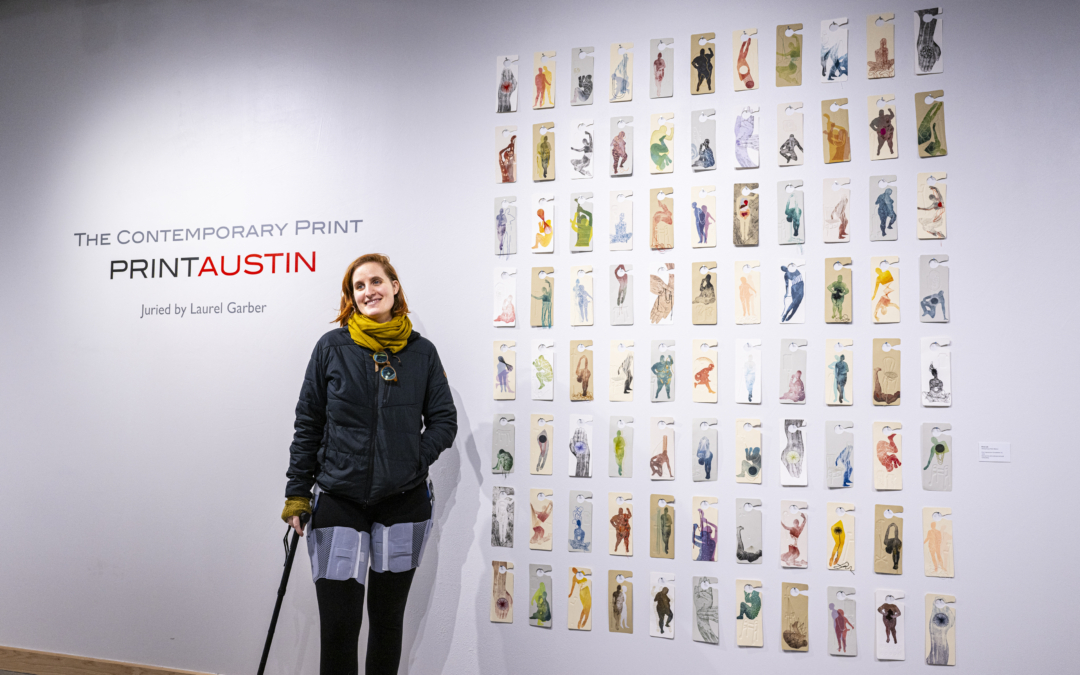A kaleidoscope of colors, textures, and figures come together in Eliza Lutz’s installation work First Impressions. Their dynamic installation transforms the universal Accessible Parking placards into fluid representations of disability and chronic illness. The work consists of 88 placards placed on the wall in a grid formation that stretches from floor to ceiling. Each one of the placards contains a unique figure, representing a different lived experience. Immediately catching the viewer’s eye are the additions of embroidery threads sewn directly into the cards. These threads may bind bodies to chairs, act as visualizations of jumbled thoughts, or represent the contents spilling out of the tip of a syringe. Other elements are more subtle, like embossments of mobility aids and medical equipment, details that are visible upon closer inspection.

Eliza Lutz, First Impressions, 2025, monoprint. Image courtesy of the artist.
In their series First Impressions, which was the Best-in-Show award winner in the 2025 The Contemporary Print exhibition at The Art Galleries (TAG) at Austin Community College, Lutz challenges the way we perceive disability, exploring both the personal and societal dimensions of chronic illness. During the Spring 2025 semester, TAG staff conducted an interview with Eliza Lutz, who is a visual artist, musician, and founder of Matron Records from Santa Fe, New Mexico. The featured works are monoprints made through a combination of intaglio printing, embossment, and embroidery. They invite viewers to reconsider their assumptions by presenting disability not as a singular, static experience, but as multifaceted one.
Lutz chose the title First Impressions as a play on words, reflecting both the assumptions people make upon first encountering someone and the physical process of printmaking, where each print is an “impression” of the original matrix. “Monoprinting is central to this work, and its inherent variation mirrors the fluid and varied experiences of disability and chronic illness,” Lutz explains.
“Each print in the series is intentionally unique, just as no two experiences of disability are exactly the same.”

A photo of First Impressions as featured at The Contemporary Print exhibition. Photo Credit: David Allen
Part of what makes each print unique is its individually assigned color. Lutz utilizes a wide array of colored inks in their monoprints, using color to “push back against the sterile, drab, and medicalized aesthetic that most people think of when they think about disability.” Although their work addresses difficult themes, Lutz emphasizes the vibrancy of the disabled identity and community.
“[First Impressions] is many things at once—I want the work to express joy and resilience just as much as it does grief and personal struggle.”
The series also plays with themes of visibility and invisibility. Many disabilities are not immediately apparent, yet perceptions shift dramatically when external markers, like a cane or wheelchair, are present. Lutz explores this dissonance through blind embossment, where the impressions of medical tools and mobility aids remain subtle or even hidden, much like some disabilities. “From a distance, these elements remain unnoticed—just as many disabilities are invisible or fluid. Up close, a single print reveals more detail, but in isolation, it may present only a narrow view,” they explain. “Stepping back to see the full collection disrupts any singular understanding.”

Photo of Eliza Lutz, taken on their visit to The Art Galleries. Photo Credit: David Allen
As a person with a disability, Lutz developed a relationship to the work’s core theme over a span of three years. Whereas First Impressions started as a personal and intimate artwork, Lutz describes the current approach as “more external, collective, and critical.” Each placard holds the weight of research that Lutz has conducted on the lives and experiences of other disabled individuals, serving as a visual manifestation of collected data.
Beyond the impressively layered meaning of the piece, Lutz uses a range of innovative techniques in First Impressions, and each placard has multiple artmaking methods applied to it. The bodies Lutz represents are printed using the intaglio method. Embroidery mingles with the embossed and printed elements, often showing the connection between people with disabilities and the aids they need for daily living. To create the embossed medical supplies in First Impressions, Lutz used a sign-making material called Sinatra.
“Sinatra is soft enough to carve and cut easily, and go safely through the press, while also being firm enough to hold up to a lot of printing. I cut out individual shapes and carve details into them with regular relief tools. I then emboss my prints by soaking them in water before running them through the press with the trinkets. I am always impressed with how well they hold up to years of use!”

Photo of the Sintra material that Lutz utilizes for blind embossing (left) and a plate used for printing (right). Image courtesy of the artist.
When asked about the desired impact on viewers, Lutz responded that they primarily want to connect with other disabled and chronically ill people. “I am very grateful for the conversations that I’ve had with folks in this community about their experiences and reactions to my work, and I’ve also formed some meaningful connections with other disabled printmakers through the project.” For those who haven’t thought about disability in-depth, Lutz trusts that the work will allow them to reflect on their understanding of it, “I hope the piece can increase awareness of the diversity of disability experiences and foster greater solidarity for disability justice and collective care.”
First Impressions was featured in the 2025 The Contemporary Print exhibition at The Art Galleries at ACC (TAG) from January 21 – March 30th, 2025. This article presents a synthesis of Lutz’s interview, highlighting key themes and insights. To read their full responses, click here. You can learn more about Eliza Lutz and their work at matronstudio.com.


Recent Comments